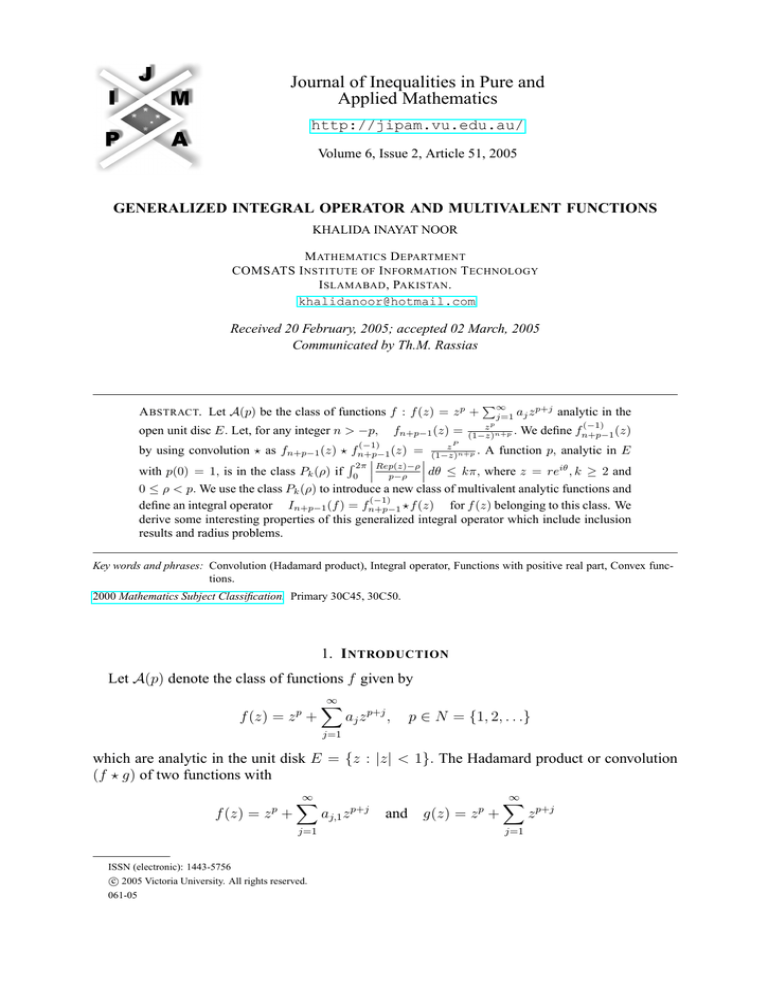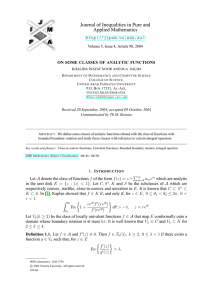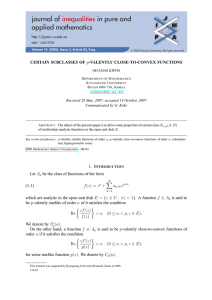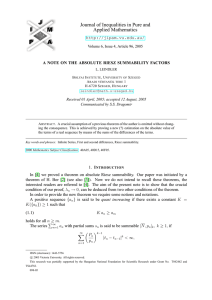
Journal of Inequalities in Pure and
Applied Mathematics
http://jipam.vu.edu.au/
Volume 6, Issue 2, Article 51, 2005
GENERALIZED INTEGRAL OPERATOR AND MULTIVALENT FUNCTIONS
KHALIDA INAYAT NOOR
M ATHEMATICS D EPARTMENT
COMSATS I NSTITUTE OF I NFORMATION T ECHNOLOGY
I SLAMABAD , PAKISTAN .
khalidanoor@hotmail.com
Received 20 February, 2005; accepted 02 March, 2005
Communicated by Th.M. Rassias
A BSTRACT. Let A(p) be the class of functions f : f (z) = z p +
open unit disc E. Let, for any integer n > −p,
fn+p−1 (z) =
P∞
j=1
p
aj z p+j analytic in the
z
(1−z)n+p .
(−1)
We define fn+p−1 (z)
P
(−1)
z
by using convolution ? as fn+p−1 (z) ? fn+p−1 (z) = (1−z)
n+p . A function p, analytic in E
R 2π Rep(z)−ρ with p(0) = 1, is in the class Pk (ρ) if 0 p−ρ dθ ≤ kπ, where z = reiθ , k ≥ 2 and
0 ≤ ρ < p. We use the class Pk (ρ) to introduce a new class of multivalent analytic functions and
(−1)
define an integral operator In+p−1 (f ) = fn+p−1 ?f (z) for f (z) belonging to this class. We
derive some interesting properties of this generalized integral operator which include inclusion
results and radius problems.
Key words and phrases: Convolution (Hadamard product), Integral operator, Functions with positive real part, Convex functions.
2000 Mathematics Subject Classification. Primary 30C45, 30C50.
1. I NTRODUCTION
Let A(p) denote the class of functions f given by
f (z) = z p +
∞
X
aj z p+j ,
p ∈ N = {1, 2, . . .}
j=1
which are analytic in the unit disk E = {z : |z| < 1}. The Hadamard product or convolution
(f ? g) of two functions with
p
f (z) = z +
∞
X
j=1
ISSN (electronic): 1443-5756
c 2005 Victoria University. All rights reserved.
061-05
aj,1 z
p+j
p
and g(z) = z +
∞
X
j=1
z p+j
2
K HALIDA I NAYAT N OOR
is given by
p
(f ? g)(z) = z +
∞
X
aj,1 aj,2 z p+j .
j=1
The integral operator In+p−1 : A(p) −→ A(p) is defined as follows, see [2].
(−1)
zp
For any integer n greater than −p, let fn+p−1 (z) = (1−z)
n+p and let fn+p−1 (z) be defined such
that
zp
(−1)
(1.1)
fn+p−1 (z) ? fn+p−1 (z) =
.
(1 − z)p+1
Then
(−1)
zp
(−1)
(1.2)
In+p−1 f (z) = fn+p−1 (z) ? f (z) =
? f (z).
(1 − z)n+p
From (1.1) and (1.2) and a well known identity for the Ruscheweyh derivative [1, 8], it follows
that
z (In+p f (z))0 = (n + p)In+p−1 f (z) − nIn+p f (z).
(1.3)
For p = 1, the identity (1.3) is given by Noor and Noor [3].
Let Pk (ρ) be the class of functions p(z) analytic in E satisfying the properties p(0) = 1 and
Z 2π Re p(z) − ρ (1.4)
p − ρ dθ ≤ kπ,
0
iθ
where z = re , k ≥ 2 and 0 ≤ ρ < p. For p = 1, this class was introduced in [5] and for ρ = 0,
see [6]. For ρ = 0, k = 2, we have the well known class P of functions with positive real
part and the class k = 2 gives us the class P (ρ) of functions with positive real part greater than
ρ. Also from (1.4), we note that p ∈ Pk (ρ) if and only if there exist p1 , p2 ∈ Pk (ρ) such that
k 1
k 1
(1.5)
p(z) =
+
p1 (z) −
−
p2 (z).
4 2
4 2
It is known [4] that the class Pk (ρ) is a convex set.
Definition 1.1. Let f ∈ A(p). Then f ∈ Tk (α, p, n, ρ) if and only if
In+p−1 f (z)
In+p f (z)
(1 − α)
+α
∈ Pk (ρ),
zp
zp
for α ≥ 0, n > −p, 0 ≤ ρ < p, k ≥ 2 and z ∈ E.
2. P RELIMINARY R ESULTS
Lemma 2.1. Let p(z) = 1 + b1 z + b2 z 2 + · · · ∈ P (ρ). Then
2(1 − ρ)
Re p(z) ≥ 2ρ − 1 +
.
1 + |z|
This result is well known.
Lemma 2.2 ([7]). If p(z) is analytic in E with p(0) = 1 and if λ1 is a complex number satisfying
Re λ1 ≥ 0, (λ1 6= 0), then Re{p(z) + λ1 zp0 (z)} > β (0 ≤ β < p) implies
Re p(z) > β + (1 − β)(2γ1 − 1),
where γ1 is given by
Z
γ1 =
1
1 + tRe λ1
−1
dt.
0
J. Inequal. Pure and Appl. Math., 6(2) Art. 51, 2005
http://jipam.vu.edu.au/
I NTEGRAL O PERATOR A ND M ULTIVALENT F UNCTIONS
3
Lemma 2.3 ([9]). If p(z) is analytic in E, p(0) = 1 and Re p(z) > 12 , z ∈ E, then for any
function F analytic in E, the function p ? F takes values in the convex hull of the image E under
F.
3. M AIN R ESULTS
Theorem 3.1. Let f ∈ Tk (α, p, n, ρ1 ) and g ∈ Tk (α, p, n, ρ2 ), and let F = f ? g. Then F ∈
Tk (α, p, n, ρ3 ) where
n+p
)−1
Z 1 ( 1−α
n+p
u
(3.1)
ρ3 = 1 − 4(1 − ρ1 )(1 − ρ2 ) 1 −
du .
1−α 0 1+u
This results is sharp.
Proof. Since f ∈ Tk (α, p, n, ρ1 ), it follows that
In+p−1 f (z)
In+p f (z)
H(z) = (1 − α)
+α
∈ Pk (ρ1 ),
zp
zp
and so using (1.3), we have
n+p
)
n + p −( 1−α
In+p f (z) =
z
1−α
(3.2)
z
Z
t
n+p
1−α −1
H(t)dt.
0
Similarly
n+p
)
n + p −( 1−α
In+p g(z) =
z
1−α
(3.3)
z
Z
t
n+p
1−α −1
H ? (t)dt,
0
?
where H ∈ Pk (ρ2 ).
Using (3.1) and (3.2), we have
(3.4)
n+p
)
n + p −( 1−α
In+p F (z) =
z
1−α
Z
z
t
n+p
1−α −1
Q(t)dt,
0
where
(3.5)
k 1
k 1
Q(z) =
+
q1 (z) −
−
q2 (z)
4 2
4 2
n+p Z z n+p
)
n + p −( 1−α
1−α −1
=
z
t
(H ? H ? )(t)dt.
1−α
0
Now
(3.6)
k 1
k 1
H(z) =
+
h1 (z) −
−
h2 (z)
4 2
4 2
k 1
k 1
?
?
H(z) =
+
h1 (z) −
−
h?2 (z),
4 2
4 2
where hi ∈ P (ρ1 ) and h?i ∈ Pk (ρ2 ), i = 1, 2.
Since
h?i (z) − ρ2 1
1
?
pi (z) =
+ ∈P
, i = 1, 2,
2(1 − ρ2 )
2
2
we obtain that (hi ? p?i )(z) ∈ P (ρ1 ), by using the Herglotz formula.
Thus
(hi ? h?i )(z) ∈ P (ρ3 )
J. Inequal. Pure and Appl. Math., 6(2) Art. 51, 2005
http://jipam.vu.edu.au/
4
K HALIDA I NAYAT N OOR
with
ρ3 = 1 − 2(1 − ρ1 )(1 − ρ2 ).
(3.7)
Using (3.4), (3.5), (3.6), (3.7) and Lemma 2.1, we have
Z
n+p
−1
n + p 1 1−α
Re qi (z) =
u
Re{(hi ? h?i )(uz)}du
1−α 0
Z
n+p
−1
2(1 − ρ3 )
n + p 1 1−α
2ρ3 − 1 +
du
≥
u
1 + u|z|
1−α 0
Z
n+p
−1
2(1 − ρ3 )
n + p 1 1−α
2ρ3 − 1 +
du
>
u
1+u
1−α 0
n+p
Z 1 1−α
−1
n+p
u
= 1 − 4(1 − ρ1 )(1 − ρ2 ) 1 −
du .
1−α 0 1+u
From this we conclude that F ∈ Tk (α, p, n, ρ3 ), where ρ3 is given by (3.1).
We discuss the sharpness as follows:
We take
k 1 1 + (1 − 2ρ1 )z
k 1 1 − (1 − 2ρ1 )z
H(z) =
+
−
−
,
4 2
1−z
4 2
1+z
k 1 1 + (1 − 2ρ2 )z
k 1 1 − (1 − 2ρ2 )z
?
H (z) =
+
−
−
.
4 2
1−z
4 2
1+z
Since
1 + (1 − 2ρ2 )z
4(1 − ρ1 )(1 − ρ2 )
1 + (1 − 2ρ1 )z
?
= 1 − 4(1 − ρ1 )(1 − ρ2 ) +
,
1−z
1−z
1−z
it follows from (3.5) that
Z
n+p
−1
n + p 1 1−α
4(1 − ρ1 )(1 − ρ2 )
qi (z) =
u
1 − 4(1 − ρ1 )(1 − ρ2 ) +
du
1−α 0
1 − uz
n+p
−1
Z 1 1−α
n+p
u
−→ 1 − 4(1 − ρ1 )(1 − ρ2 ) 1 −
du
as z −→ 1.
1−α 0 1+u
This completes the proof.
We define Jc : A(p) −→ A(p) as follows:
(3.8)
c+p
Jc (f ) =
zc
Z
z
tc−1 f (t)dt,
0
where c is real and c > −p.
Theorem 3.2. Let f ∈ Tk (α, p, n, ρ) and Jc (f ) be given by (3.8). If
In+p f (z)
In+p Jc (f )
(3.9)
(1 − α)
+α
∈ Pk (ρ),
zp
zp
then
In+p Jc (f )
zp
J. Inequal. Pure and Appl. Math., 6(2) Art. 51, 2005
∈ Pk (γ),
z∈E
http://jipam.vu.edu.au/
I NTEGRAL O PERATOR A ND M ULTIVALENT F UNCTIONS
5
and
γ = ρ(1 − ρ)(2σ − 1)
−1
Z 1
Re 1−α
λ+p
σ=
1+t
dt.
(3.10)
0
Proof. From (3.8), we have
(c + p)In+p f (z) = cIn+p Jc (f ) + z(In+p Jc (f ))0 .
Let
k 1
In+p Jc (f )
k 1
(3.11)
Hc (z) =
+
s1 (z) −
−
s2 (z) =
.
4 2
4 2
zp
From (3.9), (3.10) and (3.11), we have
In+p f (z)
In+p Jc (f )
1−α 0
(1 − α)
+α
= Hc (z) +
zH (z)
zp
zp
λ+p c
and consequently
1−α 0
si (z) +
zs (z) ∈ P (ρ), i = 1, 2.
λ+p i
Using Lemma 2.2, we have Re{si (z)} > γ where γ is given by (3.10). Thus
In+p Jc (f )
Hc (z) =
∈ Pk (γ)
zp
and this completes the proof.
Let
(3.12)
n+p
Jn (f (z)) := Jn (f ) =
zp
Z
z
tn−1 f (t)dt.
0
Then
In+p−1 Jn (f ) = In+p (f ),
and we have the following.
Theorem 3.3. Let f ∈ Tk (α, p, n + 1, ρ). Then Jn (f ) ∈ Tk (α, p, n, ρ) for z ∈ E.
Theorem 3.4. Let φ ∈ Cp , where Cp is the class of p-valent convex functions, and let f ∈
Tk (α, p, n, ρ). Then φ ? f ∈ Tk (α, p, n, ρ) for z ∈ E.
Proof. Let G = φ ? f. Then
In+p−1 G(z)
In+p G(z)
In+p−1 (φ ? f )(z)
In+p (φ ? f )(z)
(1 − α)
+α
= (1 − α)
+α
p
p
p
z
z z
zp
φ(z)
In+p−1 f (z)
In+p f (z)
= p ? (1 − α)
+
α
z
zp
zp
φ(z)
= p ? H(z), H ∈ Pk (ρ)
z
k 1
φ(z)
+
(p − ρ)
? h1 (z) + ρ
=
4 2
zp
k 1
φ(z)
−
−
(p − ρ)
? h2 (z) + ρ , h1 , h2 ∈ P.
4 2
zp
o
n
> 12 , z ∈ E and so using Lemma 2.3, we conclude that G ∈
Since φ ∈ Cp , Re φ(z)
zP
Tk (α, p, n, ρ).
J. Inequal. Pure and Appl. Math., 6(2) Art. 51, 2005
http://jipam.vu.edu.au/
6
K HALIDA I NAYAT N OOR
3.1. Applications.
(1) We can write Jc (f ) defined by (3.8) as
Jc (f ) = φc ? f,
where φc is given by
∞
X
p+c m
φc (z) =
z ,
m+c
m=p
(c > −p)
and φc ∈ Cp . Therefore, from Theorem 3.4, it follows that Jc (f ) ∈ Tk (α, p, n, ρ).
(2) Let Jn (f ), defined by (3.12), belong to Tk (α, p, n, ρ). Then f ∈ Tk (α, p, n, ρ) for |z| <
√
rn = 2+(1+n)
. In fact, Jn (f ) = Ψn ? f, where
3+n2
p
Ψn (z) = z +
∞
X
n+j−1
j=2
n+1
z j+p−1
n
zp
1
zp
·
+
·
n + 1 1 − z n + 1 (1 − z)2
=
and Ψn ∈ Cp for
1+n
√
.
2 + 3 + n2
Now In+p−1 Jn (f ) = Ψn ? In+p−1 f, and using Theorem 3.4, we obtain the result.
|z| < rn =
Theorem 3.5. For 0 ≤ α2 < α1 ,
Tk (α1 , p, n, ρ) ⊂ Tk (α2 , p, n, ρ),
z ∈ E.
Proof. For α2 = 0, the proof is immediate. Let α2 > 0 and let f ∈ Tk (α1 , p, n, ρ). Then
In+p−1 f (z)
In+p f (z)
+ α2
p
p
z z
α2
α1
In+p−1 f (z)
In+p−1 f (z)
In+p−1 f (z)
+
−1
+ (1 − α1 )
+ α1
α1
α2
zp
zp
zp
α2
α2
= 1−
H1 (z) + H2 (z), H1 , H2 ∈ Pk (ρ).
α1
α1
(1−α2 )
Since Pk (ρ) is a convex set, we conclude that f ∈ Tk (α2 , p, n, ρ) for z ∈ E.
Theorem 3.6. Let f ∈ Tk (0, p, n, ρ). Then f ∈ Tk (α, p, n, ρ) for
|z| < rα =
2α +
√
1
,
4α2 − 2α + 1
1
α 6= ,
2
0 < α < 1.
Proof. Let
zp
zp
+α
1−z
(1 − z)2
∞
X
p
=z +
(1 + (m − 1)α)z m+p−1 .
Ψα (z) = (1 − α)
m=2
Ψα ∈ Cp for
1
√
|z| < rα =
2α + 4α2 − 2α + 1
J. Inequal. Pure and Appl. Math., 6(2) Art. 51, 2005
1
α 6= ,
2
0<α<1
http://jipam.vu.edu.au/
I NTEGRAL O PERATOR A ND M ULTIVALENT F UNCTIONS
7
We can write
In+p−1 f (z)
In+p f (z)
Ψα (z) In+p−1 f (z)
(1 − α)
+α
=
?
.
p
p
z
z
zp
zp
Applying Theorem 3.4, we see that f ∈ Tk (α, p, n, ρ) for |z| < rα .
R EFERENCES
[1] R.M. GOEL AND N.S. SOHI, A new criterion for p-valent functions, Proc. Amer. Math. Soc., 78
(1980), 353–357.
[2] J.L. LIU AND K. INAYAT NOOR, Some properties of Noor integral operator, J. Natural Geometry,
21 (2002), 81–90.
[3] K. INAYAT NOOR
341–352.
AND
M.A. NOOR, On integral operators, J. Math. Anal. Appl., 238 (1999),
[4] K. INAYAT NOOR, On subclasses of close-to-convex functions of higher order, Internat. J. Math.
Math. Sci., 15(1992), 279–290.
[5] K.S. PADMANABHAN AND R. PARVATHAM, Properties of a class of functions with bounded
boundary rotation, Ann. Polon. Math., 31 (1975), 311–323.
[6] B. PINCHUK, Functions with bounded boundary rotation, Isr. J. Math., 10 (1971), 7–16.
[7] S. PONNUSAMY, Differential subordination and Bazilevic functions, Preprint.
[8] S. RUSCHEWEYH, New criteria for univalent functions, Proc. Amer. Math. Soc., 49 (1975), 109–
115.
[9] R. SINGH AND S. SINGH, Convolution properties of a class of starlike functions, Proc. Amer. Math.
Soc., 106 (1989), 145–152.
J. Inequal. Pure and Appl. Math., 6(2) Art. 51, 2005
http://jipam.vu.edu.au/












